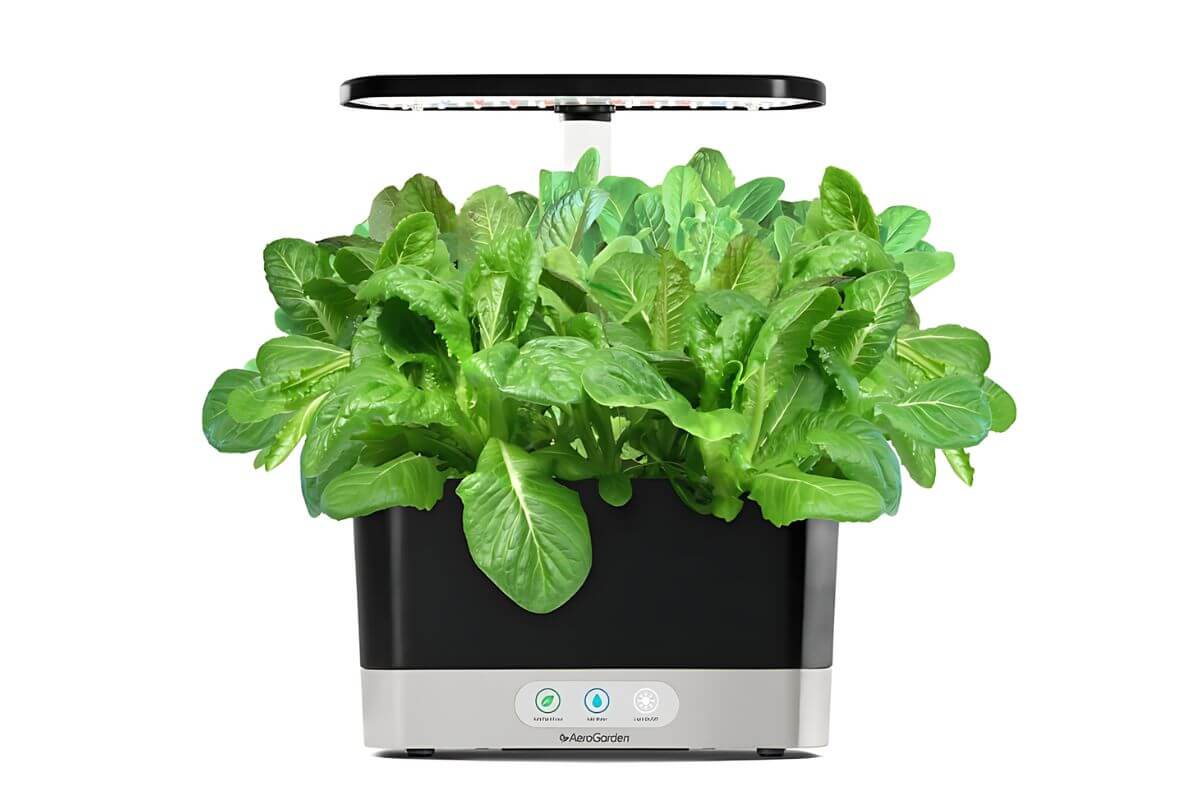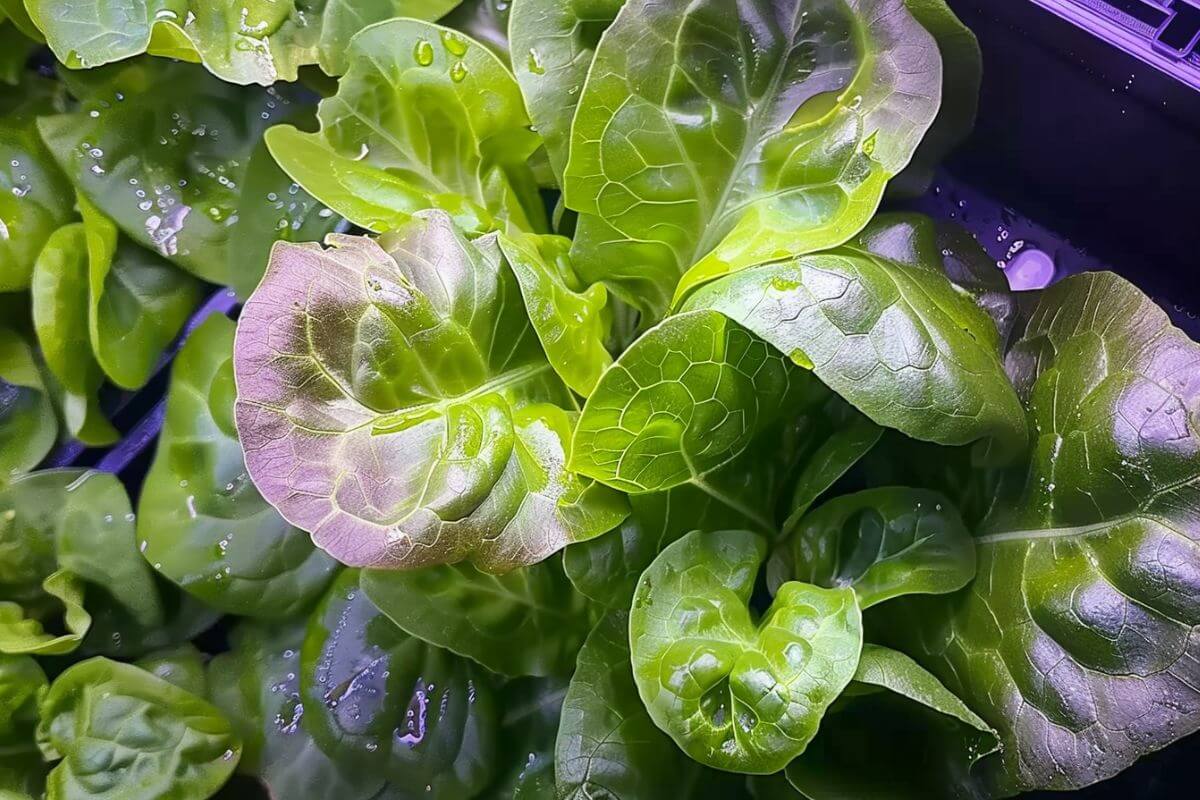Have you ever harvested lettuce from your AeroGarden only to find it unexpectedly bitter? Don’t worry, you’re not alone! Several factors can influence the taste of your homegrown greens. Understanding these reasons can help you cultivate delicious, crisp lettuce every time.
I’ll walk you through the top reasons why your AeroGarden lettuce might turn bitter and provide some tips on how you can improve your yield’s quality.
- Related article: Ideal Crops for AeroGarden
6 Key Takeaways on Bitter AeroGarden Lettuce
- Ensure you provide the right amount of nutrients in the water. Too much or too little can stress your plants and cause bitterness. Keep a log of nutrient additions for better management.
- Lettuce prefers temperatures between 60°F (15°C) and 70°F (21°C). High temperatures can cause bolting, leading to bitterness. Plant in cooler seasons and use shade cloths to protect from intense heat.
- Lettuce needs less than 14 hours of light daily. Extended daylight or prolonged LED light exposure can trigger bolting. Use shade cloths and plant in partly shaded spots to manage light levels.
- Provide steady and ample water to prevent water stress, which can cause bolting. Check soil moisture regularly and use mulch to retain soil moisture and keep your plant cool.
- Use clean, balanced water. Avoid using water with impurities that can stress the plants and lead to bitterness.
- Younger lettuce leaves are sweeter. Make sure to harvest leaves regularly to prevent aging. If leaves start tasting bitter, it’s time to compost the plant and start fresh.
Why Is My AeroGarden Lettuce Bitter?

Bitterness in lettuce can be disappointing. There are several reasons why this might happen, and understanding these factors can help you cultivate sweeter and more flavorful lettuce in your AeroGarden. Let’s explore why your lettuce might be bitter and how you can prevent it for a more enjoyable harvest.
1. Nutrient Imbalance
Growing tasty lettuce in your AeroGarden is all about a balance of nutrients. You need just the right amount of nutrients in the water. Too much or too little can stress your plants and give them that bitter flavor.
Not enough nutrients? Your lettuce won’t thrive. It’ll look sad and taste bland. But don’t go overboard either! Too many nutrients can harm your lettuce and they might not get enough water because of it.
Make sure to log in when you add the nutrient solution in. This factor is easy to forget, but important for success. You can find the right solution on AeroGarden’s website for those lettuce greens.
Happy plants with a proper balance of nutrients make for delicious salads. With the right care, you’ll be munching on crisp, flavorful lettuce in no time. Isn’t that worth a little extra attention?
2. High Temperatures
Lettuce is a cool season green. The ideal temperature range for it is between 60°F (15°C) and 70°F (21°C). This sweet spot helps your plants grow steady and strong without rushing to bolt.
What happens when it gets too hot? Your lettuce might decide it’s time to make flowers instead of leaves. This is called bolting. It’s like your lettuce is saying, “I’m done here!” it then results in rapid growth and starts to taste bitter.
Want to keep your lettuce happy longer? Here are some quick tips:
- Plant in spring or fall when temperatures are milder
- Use a shade cloth to protect your lettuce from the intense summer sun
- Water regularly to keep the soil cool and moist
- Mulch around plants to insulate roots
By keeping an eye on the temperature, you can enjoy crisp, tasty lettuce for weeks. Remember, a little extra care goes a long way in the garden.
3. Extended Daylight or Prolonged LED Light Exposure

Lettuce plants are picky about daylight. Being a cool-weather crop, they get moody when days stretch past 14 hours of light. It’s like they have a built-in alarm clock. Once it goes off, they switch gears. They stop making leaves and start thinking about flowers and seeds.
You might wonder, “Why does my lettuce suddenly shoot up?” Well, it’s all about that extra sunshine. As spring turns to summer, the days get longer. Your lettuce notices and starts to bolt.
If you’re gardening in late spring or early summer, you’ve got to outsmart the sun. Try using a shade cloth or planting your lettuce in partly shaded spots. This way, you can trick your lettuce into thinking the days are shorter.
I once tried growing lettuce in my kitchen with an AeroGarden Bounty. The constant light from my always-on LED strip made them bolt faster than outdoor plants. Lesson learned: even indoor lettuce needs some darkness!
While some varieties of lettuce are more heat resistant, it would be best to plant early in spring or late in summer for the best results.
4. Water Stress
Water can make or break your lettuce crop. I’ve learned this the hard way in my garden. Your plants need steady, ample water to thrive. When they don’t get enough, they activate survival mode and go to seed.
How do you know if your lettuce is thirsty? Look for droopy leaves, curled edges, or a dull green color. These are telltale signs your plants are struggling. Make sure to check your soil’s moisture often so that they don’t dry out to extremes. You can also add mulch to keep the ground cooler.
But it’s not just about quantity. Water quality matters too. I once used water from my rain barrel without testing it first. Big mistake! The lettuce didn’t like it one bit. I advise that you stick to clean, balanced water for best results.
5. Aged Lettuce
Younger lettuce leaves are sweeter and tastier. As lettuce ages, they lose that sweetness and become more bitter. It’s like how we get grumpy as we age, right?
Want to keep your lettuce happy? Harvest often! Don’t let those leaves hang around too long. If you do, they might start affecting the younger leaves too. It’s like one bad apple spoiling the bunch.
- Learn more in our AeroGarden Lettuce Harvest Guide
If you notice even the young leaves have a bitter taste, it’s time to say goodbye to that plant. Compost it and start fresh. You can keep any leaves that still taste good, but the rest should go.
Remember, gardening is all about trial and error. Sometimes you win and sometimes you learn. But with these tips, you’ll be on your way to growing delicious, sweet lettuce in your AeroGarden in no time!
Bitter AeroGarden Lettuce Final Thoughts
Lettuce is one of the best things to grow in an AeroGarden. However, it requires proper care to prevent lettuce bolts.
This cool-weather crop needs just the right amount of nutrients. Too much or too little can stress the plant and result in bitter-tasting lettuce. Keep an eye on when you add nutrients to make sure your plants get what they need.
Temperature matters too. Lettuce likes it cool, between 60°F and 70°F. When it gets too hot, the plant might bolt and turn bitter. Try growing in cooler seasons or use shade cloths to keep things chill.
Light is another big factor. Lettuce doesn’t like too much light. If you’re growing indoors, make sure your plants get some darkness each day.
Water stress can also lead to bitterness. Make sure to keep the soil moist but not soggy. Check it often and use mulch to keep moisture in and the soil cool. Clean, balanced water is best to avoid stressing your plants.
Finally, harvest young leaves. They’re sweeter than older ones. Pick often and don’t let leaves get too old on the plant. Remember, gardening is all about learning as you go. Pay attention to these factors and your plant will surely reward you!
Bitter AeroGarden Lettuce FAQs
1. Does Soaking Lettuce Make It Less Bitter?
Yes, it does! I’ve got a simple trick for you. Break apart the leaves and toss them in a bowl of cold water. Add a pinch of baking soda to the mix. This little soak can work wonders on that sharp taste. Give it a shot next time your greens are too tangy for your liking.
2. When to Harvest Lettuce So It’s Not Bitter?
With lettuce, you have to keep an eye on your plants. When they’re a few inches tall, you can start picking the leaves. If you see a flowering stem, you’ve waited too long and now you have bitter lettuce leaves. Remember, timing is everything.
3. Is Bitter Lettuce Safe to Eat?
Bitter lettuce can turn your salad into a real bummer. But don’t worry, it’s not harmful to eat. The problem often comes from too much heat during growing. This is actually pretty easy to fix. You can try methods like soaking it in ice water and adding a tangy dressing to balance out the bitterness.
For other guides on growing delicious herbs, fruits, and vegetables, check these out:

